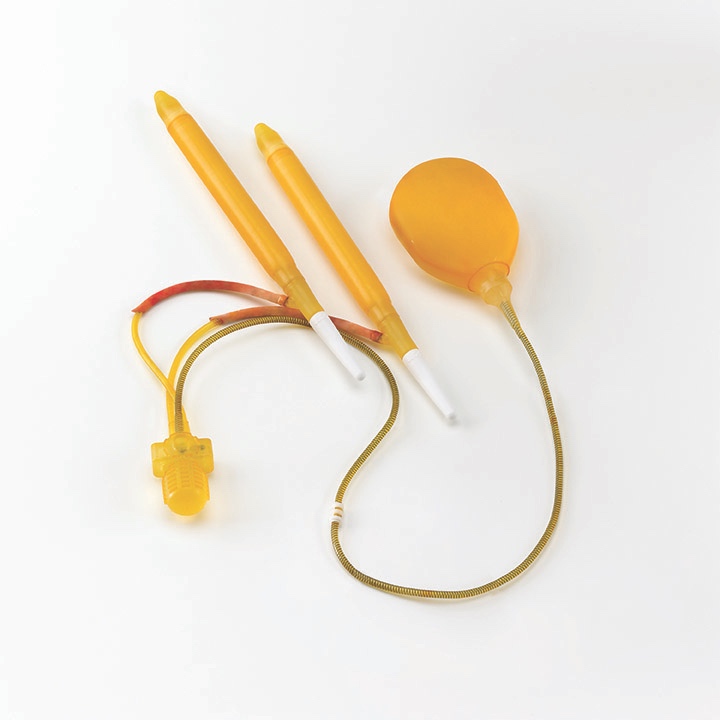
In 1959, physicians at New York's Maimonides Hospital implanted this dog with a radio receiver in its chest, part of an "auxiliary heart" system that would support a failing ticker. From the March 9, 1959 issue of LIFE:
The booster heart, developed by Drs. Adrian Kantrowitz and William McKinnon (of New York's Maimonides Hospital) is made by lifting up half of the diaphragm muscle and wrap it around the aorta, the body's main artery. Inside the chest a small radio receiver, part of an electronic system that detects and transmits the actual heart's beat, picks up the heart's rhythm and sends it by electric signals down a nerve to the diaphragm flap, making it squeeze the aorta rhythmically. This action, like a heartbeat, pumps the blood.
Kantrowitz, a pioneer in heart transplants, died in 2008.
(via Weird Universe)
Read the rest

Last year, Mohammed Abad, 43, whose penis was destroyed when he was hit by a car as a child, received an 8-inch implant involving two tubes that inflate his reconstructed flesh phallus when he pumps it up via a button in his scrotum. The implant was the culmination of years of reconstructive surgery. These kinds of implants are commonly used to treat erectile dysfunction. Abad has now announced that he will soon lose his virginity to a sex worker named Charlotte Rose, 35.
“I have waited long enough for this — it’ll be a great start to the new year," Abad said. "My penis is working perfectly now so I just want to do it. I’m really excited. I can’t wait for it to finally happen.”
Rose will travel from London to see Abad in Edinburgh.
"I am so honoured that he chose me to take his virginity," she said. "We plan to have a dinner date so we can get to know each other and then two hours of private time. I’m not charging him.”
(The British Journal)
More: "Man's 'Bionic Penis' Is Not So Rare After All" (LiveScience) Read the rest

This is a flexible mesh circuitry that Harvard nanotechnologists have injected via syringe into the heads of live mice to test a new way of monitoring brain signals from the inside. Read the rest
When I was young in the 1970s, I was blown away by photos of the 1950s battery-powered "bionic" arm invented by IBM engineer SW Alderson. The technology is now more than 60 years old and it still looks futuristic to me. Read the rest
Medical historian Thomas Schlich wrote a fascinating essay for CNN about the history of prosthetic body parts and the "Bionic Men of World War I." From his article:
In all nations involved in the war an emerging generation of so-called "war cripples," as they were referred to in Germany, loomed ominously over the pension and welfare system, and many government bureaucrats, military leaders and civilians worried about their long-term fate.
One solution was returning mutilated soldiers to the workforce. Various prostheses were designed to make that possible, pushing prosthesis manufacturing in many countries from a cottage industry towards modern mass production.
In the United States the Artificial Limb Laboratory was established in 1917 at the Walter Reed General Hospital, in conjunction with the Army Medical School, with the goal to give every amputee soldier a "modern limb," enabling them to pass as able-bodied citizens in the workplace. While the United States remained the largest producer of artificial limbs worldwide, Germany's prosthetic developments incorporated a particular quest for efficiency.
German orthopedists, engineers and scientists invented more than 300 new kinds of arms and legs and other prosthetic devices to help. Artificial legs made of wood or metal, sometimes relatively rudimentary, and often recreating the knee-joint in some way, enabled leg-amputees to stand and move around unaided.
Read the rest
Stanford researchers developed a retinal prosthesis that wirelessly transmits images from a video camera in a pair of glasses directly to a chip implanted inside the retina tissue. The innovations of lead scientist Daniel Palanker and his colleagues is that their system does away with any cable between the implant and the video eyeglasses, and buries the chip in the sub-retinal layers of the eye instead of on its surface to eliminate a kind of interference. They published their latest breakthroughs in the science journal Nature Communications. From Medical Daily:
In this study, Palanker's team from the Hansen Experimental Physics Laboratory placed these second-generation implants into the retinas of rats with or without macular degeneration. The researchers found that the new bionic retinas could transmit images into the minds of rats, which was observed by measuring brain activity in the visual centers of the rodents' brains.
"
Solar-Powered Bionic Eye Developed By Stanford Scientist"
(Medical Daily)
Restoration of Sight to the Blind: Optoelectronic Retinal Prosthesis (Daniel Palanker) Read the rest
This is Rex, a $1 million "bionic man" built in the UK by roboticists Richard Walker and Matthew Godden. Rex was the star of a new Channel 4 documentary titled "
How to Build A Bionic Man." Rex is outfitted with a variety of synthetic systems and appendages, from prosthetic limbs to a cochlear implant, artificial pancreas to retinal implant. He's now on display at the London Science Museum but will visit America in October to promote the Smithsonian Channel's US premier of the documentary, retitled "Cyborg/Frankenstein."
Read the rest
31-year-old amputee Zac Vawter made medical history Sunday, climbing 103 stories of the Willis Tower with a state-of-the-art bionic leg controlled by electrical impulses from the muscles in his upper leg, including a rewired hamstring. He finished the climb in 45 minutes. More at the Chicago Trib, and CNN. Read the rest



